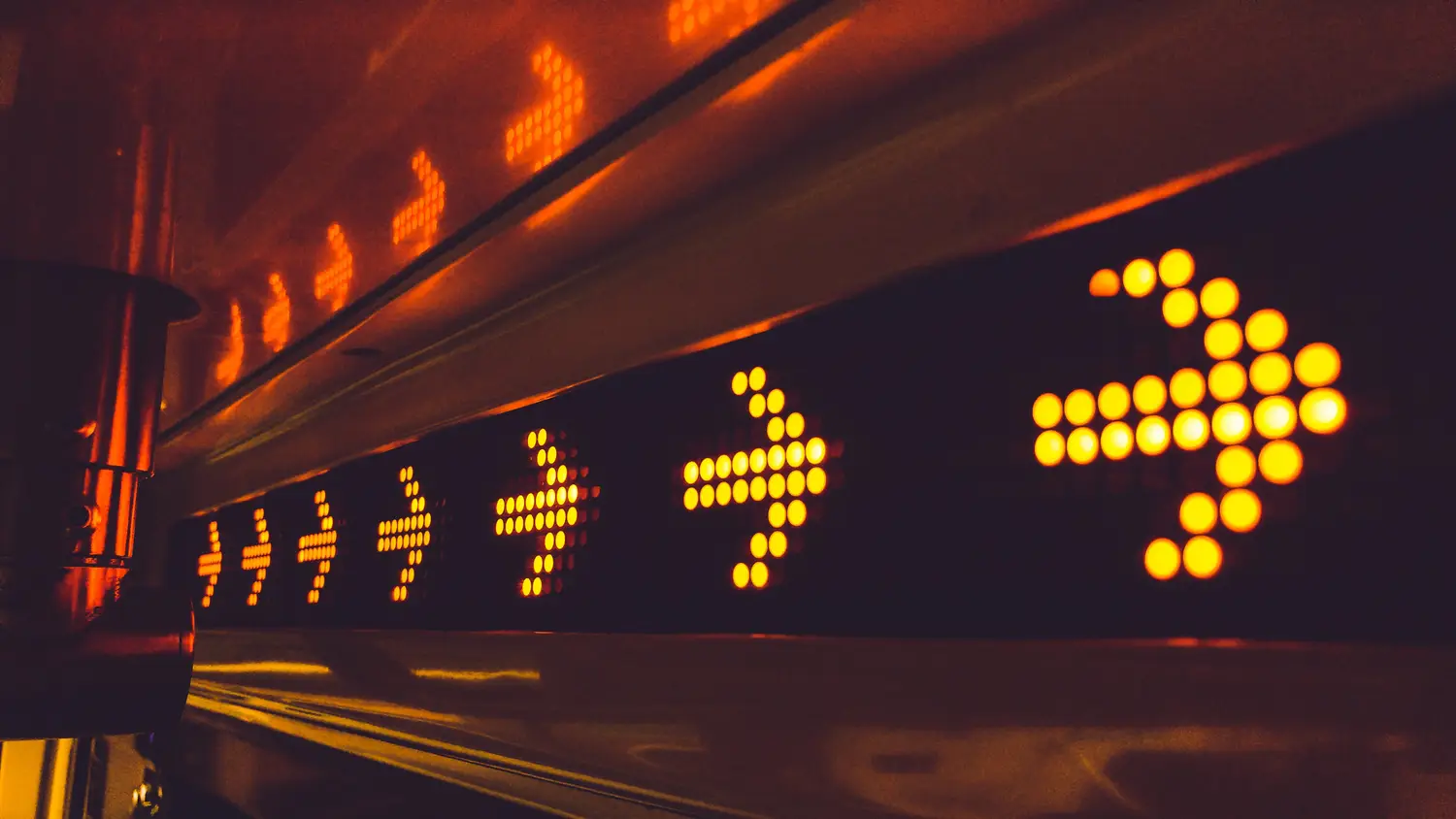About Directional Signage
Directional signage is an important part of wayfinding infrastructure, such as what you see in healthcare facilities, airports, shopping centers, and educational buildings. This type of signage helps make navigating large, complex spaces easier.
What Is Directional Signage?
Large buildings need directional signage, but what exactly is it?
Answer: Directional signage is a type of wayfinding sign. Typically, these signs are made from durable materials such as metal, plastic, wood, or vinyl. They feature bold, legible typography and universally recognizable symbols or pictograms.
The production of these signs requires careful consideration of color contrast and size for optimal visibility and accessibility.
Directional Signage Example
The guidance arrows that you see in airports and train stations are an example of directional signage. These signs often work in conjunction with station information displays.
Keep in mind that some information displays also double as directional signs. For instance, if a display has text that says, “Turn right,” it could be considered a directional sign.
Side Note: At Yaham, our Passenger Information Display Systems (PIDS) are designed to be easily understood at a glance; the goal is to help even first-time visitors find their way without confusion.
Visit our Station Information Display page to learn more about our Yaham PID traffic system.
How Much Does Directional Signage Cost?
The cost of directional signage depends on whether it is by itself or part of a larger navigational system with unique requirements.
Simple directional signage, such as entrance and exit signs, directional arrows, and floor directories, can cost anywhere from $20 to $300 per sign. Of these signs, directories are usually the most expensive.
Larger welcome signs, meanwhile, such as what you’d find at the front of a college campus, are significantly more expensive than directories.
What Is Directional Signage Used For?
Directional signage is primarily used to guide people through public buildings with multiple pathways, intersections, and/or decision points.
Other uses of directional signage include:
- Indicating the flow of traffic within parking lots and garages
- Pointing out the locations of different stores or departments within malls
- Leading attendees to various sections or booths at trade shows and exhibitions
- Showing directions to amenities like restrooms, elevators, or emergency exits
- Guiding passengers to ticket counters, platforms, or baggage claim areas
- Assisting patients and visitors in navigating hospital corridors
- Directing students and faculty to classrooms, lecture halls, or administrative offices
What Are The Types of Directional Signs?
There are several types of directional signs, which include:
- Entrance and exit signs
- Room identifiers (e.g., Conference Room 501)
- Navigational arrows
- Floor directories
- End directional sign (destination sign)
- Evacuation map
- Restroom signs (with navigational arrow)
- Elevator and stairway signs
- Queue signs (e.g., Ticket Line Starts Here)
- Transit route signs
- Boarding gate signs
- Accessible route signs (signs that indicate ADA-compliant routes)
- Aisle and bay markers in stores
- Outdoor trail signs (e.g., Summit: 3 Miles, This Way)
Directional Signage For Events
Directional signage is worth the investment, especially if you’re expecting a large crowd.
Here are some specific reasons why you should consider using directional signs at your event:
Crowd Management
Strategic placement of signs can help manage the flow of attendees, preventing bottlenecks at key points such as entrances, corridors, and session rooms.
Safety and Security
In the case of an emergency, well-placed directional signage can facilitate a quick and orderly evacuation.
Accessibility
Proper directional signage ensures that all attendees, including those with disabilities, can navigate the event space.
Engagement Opportunities
Directional signage can be used to guide attendees to booths, demonstrations, and networking areas to increase participation.
What Makes an Effective Directional Sign?
An effective directional sign is clear, concise, and easy to understand.
Additionally, directional signs have the following characteristics:
- Visibility: Directional signs stand out from a distance or in a crowd
- Readability: The sign’s font is legible with contrast between text and background
- Simplicity: The message is straightforward, avoiding clutter and confusion
- Consistency: Uses consistent design elements, symbols, and colors
- Universal symbols: Incorporates universally recognized icons or pictograms
- Directional cues: Has arrows or pointers that indicate direction effectively
- Placement: Positioned at strategic locations, such as intersections and entries
- Multilingual text: Uses multiple languages where necessary
- Illumination: Is well-lit or backlit in environments with low lighting
- Accessibility: Complies with ADA guidelines
Further characteristics of directional signs include:
Typography
The specific fonts used on directional signs are often sans-serif for better legibility.
Color Coding
The colors used on directional signs are chosen based on their visibility and psychological impact.
For example, different colors are assigned to various departments in hospitals for ease of navigation: maternity wards might use pink, pediatrics could be signified with a light blue, while emergency signs are often red.
Size and Scale
In large buildings like malls or hospitals, directional signs and their text are sized according to the typical viewing range of an average person.
During installation, our team takes careful consideration of your sign’s size and where it is being installed. We also consider other visibility factors.
Mounting and installation
Before installation, directional signs require consideration of height, orientation, and location for optimal visibility.
Additionally, the mounting process sometimes requires specialized fixtures to secure signs in place, especially in areas with high foot traffic or environmental considerations.
We consider these factors in our price quote. Call us for more details.
Lighting
For signs that require illumination, options usually include LED backlighting or external lighting.
Reflectivity
Roadway directional signs often utilize retroreflective sheeting, which bounces light from headlights back toward the driver, making the sign readable at night.
Interactive elements
Some modern directional signs include interactive elements, such as QR codes that link to maps when scanned with a smartphone.
Durability testing
Directional signs often undergo rigorous testing to ensure they can endure environmental stressors, such as extreme temperatures, moisture, and exposure to chemicals or salt (in coastal or winter areas).
Wayfinding Signage vs Directional Signage
Wayfinding signage is the overall system that helps people figure out where they are and how to get where they want to go. It includes four types of signs. Directional signage is simply one of these four types.
In other words, directional signage is a subset of wayfinding signage.
The 4 Types of Wayfinding Signage
The four types of wayfinding signage are:
- Directional Signage: Uses arrows and text to guide people through a building
- Identification Signage: Marks important areas and destinations
- Informational Signage: Offers helpful information, such as names of nearby facilities
- Regulatory Signage: Focuses on public safety, rules, and guidelines.
Indoor Directional Signage and More with Yaham
Indoor directional signage is an integral part of signage systems today. Yaham enhances these systems with high-quality displays in stadiums, airports, train stations, public spaces, and more.
Yaham’s Flight Information Display
Learn more: Yaham’s Flight Information Display
Station Information Display
Learn more: Yaham’s Station Information Display
Fixed Variable Message Sign
Learn more: Yaham’s Fixed Variable Message Sign
Contact Yaham
Yaham has over 25 years of experience offering signage solutions to customers in over 112 countries, with 50,000 successful installs.
To learn more about our services, book a consultation today.



